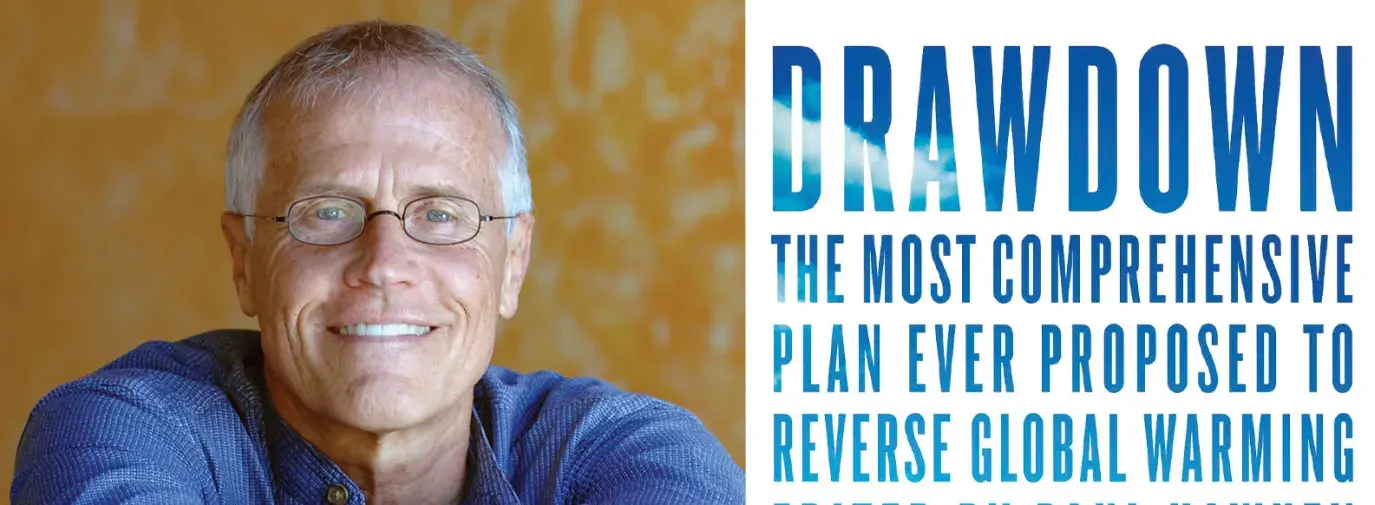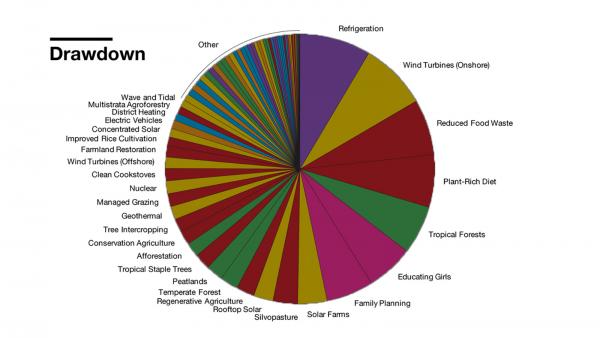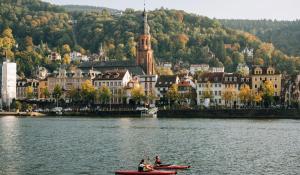
If you’re part of the movement for a just and sustainable future, or you're interested in solutions to reverse the climate crisis, chances are you’ve heard of Paul Hawken. To say that Hawken has an interesting background is a bit of an understatement.
You might know him as a green entrepreneur. Starting in the 1960s, he founded several pioneering green businesses, starting with the Erewhon Trading Company, one of the first natural-food companies in the US to rely solely on sustainable agricultural methods.
You might know him as a bestselling author. He’s published several books on the green economy, five of which have become national bestsellers—including The Ecology of Commerce (HarperCollins, 1993), which professors from 67 business schools voted as the number-one college text on business and the environment. His 1987 book, Growing a Business (Simon & Schuster), was the subject of an acclaimed 17-part PBS miniseries, which he hosted and produced.
You might know him as a compelling public speaker. In addition to being a regular on our Green Festival circuit, Hawken has given hundreds of talks around the world, at colleges and universities, to government agencies, and before world leaders.
But what he’d like you to know him for now is as a champion of 100 scientific solutions that can solve the climate crisis.
Hawken’s latest New York Times bestseller, Drawdown: The Most Comprehensive Plan Ever Proposed to Reverse Global Warming (Penguin Books, 2017), is the compilation of research from more than 200 scientists, policymakers, and experts, detailing 100 bold solutions that could get the world to “drawdown”—or the point where greenhouse gases in the atmosphere peak and then begin to decline—and beyond. He’s also launched a new organization, Project Drawdown (drawdown.org), to help get us there.
Green America editor-in-chief Tracy Fernandez Rysavy talked with Hawken about Project Drawdown and what everyone can do to help it succeed.

100 Reasons for Hope on Climate: Project Drawdown created climate and financial models for 80 solutions to climate change, and examined 20 more solutions that are forthcoming in the future. The researchers found that if the world implements the initial 80 solutions over a 30-year period using a “reasonable yet optimistic forecast,” the total amount of CO2 avoided and sequestered amounts to 1,051 gigatons by 2050. To achieve “drawdown,” or the point where greenhouse gases in the atmosphere begin to decline, we’d need to ramp them up a bit more, particularly renewable energy, to get to 1,442 gigatons by 2050.
Green American/Tracy Fernandez Rysavy: What is Project Drawdown, and how did it come about?
Paul Hawken: Drawdown started at two different times: In 2001, the Third Assessment of the IPCC [United Nations Intergovernmental Panel on Climate Change] came out. [Editor’s note: The IPCC Third Assessment Report is widely known for establishing a scientific near-consensus that unnatural levels of global warming are occurring and are caused by human activity.] I began to ask people, “Where do we stand? Do we have the solutions at hand? Can we reverse this? Why are we not talking about reversal?”
Then, as now, the discussion was about slowing, stabilization, and mitigation. I said we should do the research and find out what technologies we have at hand that can reduce emissions or sequester them. Everybody I talked to at big NGOs [non-governmental organizations] thought it was a great idea but didn’t have the expertise. And I said, “I don’t either.”
For a couple of years, I was trying to induce somebody to do the work, and nobody wanted to. Eventually, I stopped asking. Then Bill McKibben’s piece in Rolling Stone came out in July of 2012. The title was “Global Warming’s Terrifying Math,” based on Mark Campanale’s research at the Carbon Tracker Initiative. Mark had been a financial analyst, so he analyzed the balance sheets of all the gas and oil companies, and basically pointed out that they had assets that are called unburnable carbon. In other words, if those assets were combusted, the Earth would be more like Venus—we wouldn’t even be here to combust them. According to Mark, Bill turned that data into poetry.
I had many friends come to me in despair after reading Bill’s piece. Many of them independently said, “It’s game over. We’ve lost.”
I remembered what I’d been proposing in 2001. I also thought that when people give up, it’s an opening, not a closing. Surrender is usually an opening.
So with a few friends,we created Project Drawdown to map, measure, and model the most substantive solutions to global warming in terms of impact. These are solutions that are currently in place, at hand, and that are all scaling. We wanted to know what we can do with what we have now.
We ended up with 100 solutions that, if we continue to scale them at a reasonable level, achieve “drawdown,” that point in time when greenhouse gases peak and go down on a year-to-year basis.
Green American/Tracy: What was so exciting for me in reading your book is that for the first time, experts are talking about reversing climate change, not just mitigating it.
Paul Hawken: Exactly. “Mitigation” means to reduce pain, severity, and seriousness. Can we make global warming less severe? What an underwhelming goal that is. Mitigation is for triage in an ER, but it’s not for civilization and the Earth.
The science on climate change is an extraordinary problem statement. The headlines that come out about extreme weather, fire, ocean acidification, and so on, all validate the problem statement. But what’s happening is that we keep immersing ourselves in the problem statement rather than accepting it and saying, “Got it. The problem statement is correct. Now let’s work on the solutions.”
Today, we have knowledgeable people constantly repeating the idea that what we need is solar, wind, Elon Musk, and cutting back on how many burgers we eat. The implication is that if we move to clean energy and electric vehicles, we get a hall pass to the 22nd century. That’s a scientific howler. It’s not true. Of course, those are crucial solutions, no question—we can’t achieve drawdown without them, but it requires more than that. The system caused the problem, so it’s the system that heals it. That means we need all of the solutions, large and small.
Project Drawdown did the math on the most impactful solutions, pure, straight, and simple. Without bias. Without a foregone conclusion. Without the idea that we knew what the most substantive solutions are.
Over 230 people are involved—we are a coalition. We are a “we.” We didn’t try to be right. We just tried to do the math.
When you look at the back of book (or website) and see the bios of who is involved, you meet some wonderful, knowledgeable people.
Green American/Tracy: Tell me more about the math.
Paul Hawken: There are only two things we can do about global warming: Stop putting greenhouse gases up there, and bring them back home to Earth.
With a group of Research Fellows from 22 countries—all with extensive academic and professional experience from some of the world’s most respected institutions—we gathered comprehensive lists of climate solutions and winnowed them down to those that had the greatest potential to reduce emissions or sequester carbon from the atmosphere. We then compiled literature reviews and devised detailed financial and climate models for each.
The analyses were put through a three-stage process including review by outside experts, who evaluated the inputs, sources, and calculations. We also engaged a 120-person advisory board made up of diverse and prominent engineers, agronomists, politicians, writers, economists, climatologists, biologists, botanists, financial analysts, architects, and activists who reviewed and validated the final text.
With respect to greenhouse gases, we relied completely on peer-reviewed science, using the more conservative data where there is a spread. On the financial side, the measurement of cost and return, we only used data from the most respected international organizations: the IEA, FAO, World Bank, IPCC, etc. And again, we were conservative on costs and the rate at which costs would go down. The data employed in the models is not our data. We are transparent about where it comes from. We reflect back to the world what the world actually knows. It’s just that no one had ever put it together so that we could see it.

NASA has long been the leading experimenter in future aircraft design (Drawdown solution #43). They believe new designs could reduce fuel and pollution by 70 percent. Adopting the latest and most fuel-efficient aircraft, retrofitting existing aircraft, and retiring old aircraft early could prevent the release of 5.1 gigatons of CO2-equivalent by 2050. (Photo courtesy of NASA)
Green American/Tracy: I’m still stunned by how optimistic the results are—which I think could go a long way toward moving people in a productive direction.
Paul Hawken: People do say it’s optimistic. We think of it as a reality project. What we know and what we are actually doing has been obscured. Ninety-eight percent of the news about climate is bad news; it is about doom, fear, and threat. What do individuals feel like when they’re inundated with bad news? They disengage; they become numb. We’re all the same in that way.
What we know about how the brain works, from neuroscience and the study of ourselves, is that how global warming is being communicated by the climate establishment defies what we know about how the mind works. We hear over and over again that we must not exceed 2° C of warming, and if we go past that temperature, we enter some kind of wormhole, where something terrible is going to happen. That kind of rhetoric is guaranteed to turn people off. And the fact is, terrible things are already happening, i.e. Puerto Rico.
The truth is, that’s not a science-based number. That number was made up by Hans Joachim Schellnhuber in 1994. He was trying to communicate to German government officials the dangers of climate change, and they were having trouble understanding the science. So he said, “Think of it this way. We can’t go past 2° C.” It was pulled out of the air, and we’ve been using it ever since as if it’s enshrined like the Virgin Mary.
Even if it was a science-based target, it’s a future existential threat, which human beings don’t relate to. The human brain isn’t wired to respond to future existential threats. The people who did that are not in the gene pool. The people who live here today have ancestors who thought about current existential threats. That’s evolution.
Basically, the communication that is currently practiced is guaranteed not to work.
People come together around opportunity and possibility, not the probability of disaster. The way to reverse global warming is to address current human needs.
Going back to Drawdown, 98 of the 100 solutions are regenerative development. If you do them, we’re better off with respect to life in a measurable way, whether it’s water, food, grassland, soil health, marine life, pollinators, etc. In other words, the development, when completed, leaves the world better off than when we started.
We currently practice degenerative development. We’re stealing the future, selling it in the present, and calling it gross domestic product.
What global warming is inviting us to do is heal the future and sell that in the present. We can monetize the healing just as we can the stealing of the Earth.
If you break down the solutions in Drawdown, they create jobs and almost all are profitable. If we tax carbon and stop subsidizing everything that’s harmful, they are virtually all profitable. They create social stability, crop productivity, and better food. They increase soil health, biodiversity, water retention, and clean air. They reverse marine desertification and coral bleaching. The list goes on and on.
Every one of these solutions—other than two of them—are no-regrets solutions. If we were clueless about extreme weather (“Well, that was a hell of a hurricane!”), we would want to do 98 percent of these solutions regardless, because they have so many benefits and no downside.
Drawdown is not about trying to fight climate change. That’s an unfortunate phrase. It makes the need to address climate change into a war metaphor. We have enough war metaphors, and wars for that matter.
In any case, we’re not going to “fight” the atmosphere because it is impossible. It would be like fighting wind, sunshine, and ocean currents. The climate is supposed to change—that’s what climates do.

Bepkaeti of the Kayapo Tribe in Brazil sits on a mountain overlooking Kayapo territory—and also one of world’s largest protected rainforests. Indigenous communities are creating some of the most effective climate solutions through land management (Drawdown solution #39). If the world stops encroaching and allows Indigenous peoples to manage the 909 million acres of land they live on but do not have secure rights to globally, it could reduce greenhouse emissions by 6.1 gigatons (GT) by 2050. Photo by Neil Ever Osborne.
Green American/Tracy: What were some of the most surprising solutions to the climate crisis you've found?
Paul Hawken: We were just surprised, period. Like anybody, if we had made a list of what we thought were the top solutions, renewable energy would have been at the top. Transportation would have been way up there, too. In the office, we all had our own pets and guesses, and we were pretty much all wrong.
The very top one, refrigerant management, surprised us. We wished something sexier was number one, but that was how it turned out.
Number two is onshore wind—not a surprise. But number three was reduced food waste and number four, adopt a plant-rich diet. Those surprised us not as solutions, but as rankings that were so high. Also, food waste doesn’t include the methane impact of landfilled food. Put that in, and food waste could be number one.
When it comes to a plant-rich diet, it’s really about getting the world to adopt a diet where a significant part is plant-based, and a diet where we are eating proper amounts of protein. We overconsume protein in the west, much to the detriment of our health and the health of the planet.
Number five is protecting tropical forests. Tropical forests are sitting on more CO2 than is in the atmosphere. Destruction, deforestation and degradation pose a huge threat to us. Number five is about protection, preventing it from being a growing problem.
Number six was a surprise: educating girls. As was seven, clinics to support family planning and women’s reproductive health—not just in the developing world but here in places like Alabama.
Both issues are intertwined: If you leave girls in school and support their education, they tend to plan their families very differently. When they’re married off early, which happens all over the world for cultural and religious reasons, their choices are made for them. Educated girls become women who make different family choices: they’ll have an average of two children rather than five or six. It’s the difference between high and median world-population predictions. Put six and seven together, and it becomes the number-one solution. We think it’s a solar panel that’s going to save the world. It’s not a panel—it’s a woman!
I just want to make clear that by measuring impact in terms of carbon, we’re not trying to be reductionist. We should educate girls based on a list as long as your arm. Education has cascading benefits for them, for society, for communities, for the future. Having said that, no one had looked at the impact of doing so in terms of climate. We did.
Green American/Tracy: The two “regrets solutions” you mentioned are nuclear and waste-to-energy, correct? Why include those?
Paul Hawken: Yes, that’s right. They’re there because we set out to measure most substantive solutions. If, in the process of doing that, we started weeding things out because we didn’t support them, our objectivity would have been called into question. The fact is, for many people, nuclear and waste-to-energy [WTE] are solutions.
Personally, I think nuclear is the most absurd way humanity has ever invented to boil water. Generating and guarding radioactive waste is dangerous and complex. That’s my opinion, right? But as a research institution, we wanted to make sure everybody thought we had done our homework, which was to be objective. This is science. The fact is that nuclear energy is less carbon intensive than coal and natural gas. So we mapped, measured, and modeled it.
The problem with WTE is that it doesn’t go upstream, to who made the waste. It stops a better solution, which is zero waste. WTE is done in a very clean way in Europe, but even if it’s just spotless, we shouldn’t be making crap and burning it. We should be making everything in such a way that it can be returned through biological processes.
[Editor’s note: Green America is against expanding WTE and nuclear power for the reasons Paul Hawken describes above. In addition, when it comes to nuclear, mining and enriching uranium, constructing power plants, and dealing with processing and storing nuclear waste all generate carbon pollution. For more on our position, see our article, “10 Reasons to Oppose Nuclear Energy”]
.jpg)
As cities around the world become denser and city planners invest in making those cities walkable (Drawdown solution #54), five percent of trips currently made by car could be made by foot, resulting in the avoidance of 2.9 GT of CO2-equivalent. Photo by Martin Bond for Alamy.
Green American/Tracy: I want to go back to the idea that some of the Project’s solutions have other benefits. Can you talk a bit more about those?
Paul Hawken: Take number 11, regenerative agriculture, for example. When you restore soil health, you’re increasing water retention. You’re taking carbon out of the air, creating humus and more life in the soil, which gives resiliency to crops in drought years. You reduce runoff/floods. You’re eliminating nitrous oxide. You’re increasing pollinators, because you’re planting cover crops. You’re not tilling soil, so you’re not releasing CO2.
You’re increasing productivity, so you’re making money. That’s good for farmers. They’re not making much money now; thus, they’re getting more dependent on chemicals to try to squeeze out one last little bit of productivity on their exhausted soil, which is becoming dirt. Big Ag is basically like a drug dealer.
You’re introducing animals as a way to fertilize. You’re not using mineral fertilizers. You’re not making things out of natural gas to put on soil. The amount of inputs is reduced, if not eliminated.
These farms exist, and these farmers are not progressive, liberal Democrats. They’re farmers. But they’re focused on one thing: soil health. Which leads to healthy animals, people, air, water. It’s a virtuous circle, and everyone benefits. That’s just one example.
[Editor’s note: Green America has a new programs on regenerative agriculture, called Re(Store) It!]

While the 100 Project Drawdown climate solutions are all technologies available now and scalable, the researchers also included “coming attractions,” or technologies that are currently in development. One of those technologies is smart highways. The Wattway solar road, pictured above and developed in France, is made of solar tiles that adhere to existing roadways to produce electricity. A 10-by-20-foot section can supply the electricity requirements for an average French home. Photo by Vincent Capman/Getty Images.
Green American/Tracy: Can you tell our readers about some of the newer technologies that are part of the solutions list?
Paul Hawken: 80 of them are well in hand, and we have lots of data. The 20 that we called “coming attractions” are valid scientifically, but there’s not sufficient data to model them.
With the solutions that are in place, well understood and practiced, we can achieve climate reversal. However, what we’re trying to show is that things aren’t static. There are companies, engineers, designers, bioneers, people all over the world who are innovating, creating, and imagining new solutions and technologies. It’s not all that’s going to happen in the next 20 to 30 years.
But reinforcements are on the way—extraordinary breakthroughs in design and technology and practice that are going to enhance the ones we modeled. We wanted to give people a sense of
what’s coming.
Green American/Tracy: America is so politically divided right now. Are the Project’s solutions more things that Democrats embrace, or are they like regenerative agriculture, able to cross current political party lines?
Paul Hawken: Well, let’s be honest. Washington never did much about climate, whether Democrat or Republican. These solutions aren’t coming from Washington. Could they be greatly accelerated by Washington? Yes. You see it in countries like Germany and even in non-democratic countries like China, who have taken the lead. But just because government doesn’t take the lead doesn’t mean it’s not going to happen. The poster boy for wind energy is Georgetown, TX—which has a Republican mayor and is a conservative town. It’s a Trump town. But the whole town is 100 percent renewable!
This is not a liberal or conservative agenda. This is the human agenda. When people stop for a minute and look at the solutions for what they are themselves, they’re not political. They’re actually about energy, food, water, housing, costs, etc. About
safety, human health. People vote with their dollars for what protects them, their family, their children, for what serves them.
In this book, we don’t make people wrong. We don’t demonize. It’s about the future. Nobody is right about the future. It’s about having some humility and the capacity to learn and listen. The problem isn’t Congress. It’s our conversations—how we talk to each other.
Because most of the news we get is about the corruption, ignorance, and perfidy of human beings in power, it obscures how extraordinary we are. We wanted to bring a different message—we’re actually really good people.
Green American/Tracy: Going back a bit, I loved what you said about global warming being an invitation. It’s a whole new mindset that’s very empowering.
Paul Hawken: Generally, we think of global warming as happening to us. We screwed up in the past, and we’re still screwing up. There’s an implied guilt of individuals and shaming of companies.
But we need to ask ourselves this question: Is global warming happening to us or for us? If it’s happening to you, you’re the victim and disempowered. You probably will fight or think that way. Or be angry. Or be resigned.
Or you can think about it happening for us, for you. This Earth is a system—beautiful, miraculous, intricate, extraordinarily sacred. When the weather changes, there’s feedback. Anytime you ignore feedback from a system, the system perishes. Global warming is feedback. It’s actually a gift. It’s an offering. It’s a gentle nudge.
Okay, it doesn’t feel very gentle. But if you step back, it’s a slight variation in global temperatures. Addressing it is a pathway to transformation, creating a far better civilization than the one we live in now. Far kinder, more compassionate, more inventive, cleaner, restorative. Once you think of it as for you, you can take 100 percent responsibility. It’s totally liberating to be the person who is going to address and solve something. The point is that it invites creativity, imagination, celebration. It invites you to be an extraordinary human being. It’s also about knowing that you can’t do it alone.
I’ve had the same editor for 25 years. I adore my editor, and he adores me. And my publisher, Penguin Random House, was hesitant to publish the book because climate books do not sell. The concern was that it’s another book about what global warming is and how fast it’s getting worse, that is was too expensive, a full-color book with 100 percent post-consumer waste paper. The concern was that they were going to get stuck with these books. The reason it’s out now is because the publisher at Penguin, Katherine Court, said to her people, “If we don’t publish this book, why are we here?”
It became a bestseller its first week. It went into its seventh printing in six months. The last printing was 31,000 copies—we’re printing more copies than when we started.
What it tells us is that people want to do something. We want to know what to do, and we want to do it together.
Green American/Tracy: So, if I’m wondering what to do to support Drawdown, where do I start?
Paul Hawken: Do whatever is important to you on an individual level. What we’re seeing is people getting together in different ways: They’re coming together to help us research data—we have experts and organizations from universities around the world.
People want to game-ify it for kids, so they learn how to reverse global warming. There’s been tremendous curriculum development by educators, K-12 and college.
Cities and local communities are organizing Project Drawdown action plans. There’s Drawdown Marin, Drawdown Nova Scotia. Faith communities are putting together groups. People are doing TV shows, and there’s a documentary film in the works.
We’re working with people who are making solution accelerators, developing platforms and products that are leading us to drawdown and beyond.
Then there are impact investors and family funds who are working together to seek out investments—where should we and shouldn’t we put our money to achieve drawdown.
What lights you up? Where do you go wow? Maybe it’s educating girls or literacy overall. Wherever it is, that’s where you’re understood, respected, where you have friends, and you can start there.







